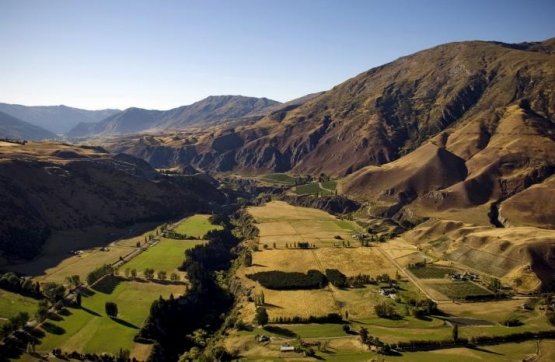(see part one)
Wild Earth is a beautiful example of the character of Central Otago and of the huge diversity of the local wineries: almost perched on a difficult terrain, it uses its rustic character and its small size as its emblem; it is just as difficult to arrive to Chard Farm, a winery which has a much larger production. Chard Farm, located in the Gibbston Valley, close to Queenstown, of course stands out thanks to its pinot noir - River Run 2010 can be enjoyed thanks to its young and fresh character while among the selections a slight preference goes to Viper because of its structure – and even the slightly citrusy and solid riesling, the 2011 vintage in particular, deserves a mention.

Amisfield'external garden: a great pinot noir named RKV
Also in the Gibbston Valley, which tends to be fresher and generally offers more complex wines (the same goes for the opposite side of the region, that is to say closer to Wanaka) there’s
Amisfield which has the bistro and the modern building as its main attractions, and has a wide range of wines that can be bought on location too. Their pinot noir
RKV is imposing – the 2008 vintage is currently available though the palate is somewhat below expectations despite a very complex nose.
Cum grano salis?
Two of the research projects undertaken by the University of Otago
Centre For Sustainability include wine within a socio-economic analysis of the territory: besides numbers, the attention was given to the market and to the perception of quality, both according to the consumers and the producers. To tell the truth, the picture that emerges is a little vague: the legislation in New Zealand is not as complex as the Italian one and if on one hand producers prefer to be more free when it comes to producing protocols and result limitations, on the other hand they seem to complain about the lack of instruments that would help consumers not just to “move” around the market but in fact to choose their very own wines!

The Gibbston Valley, part of the Wakatipu Basin, in Otago region
Some of the historic producers, that is to say those behind the birth of this denomination in the mid ‘80s, claim their merit and stand out as the soloists while the others are left to the chorus. If you visit a producer such as
Rippon, in Wanaka, however, it is impossible not to notice the different approach of this soloist, both in terms of wines and of philosophy.
Rippon, as many others, makes wine “his own way”; defining his work would mean being able to perfectly distinguish “organic” from “biodynamic” from “natural” in order to obtain a unique and binding definition that would not be limited to the necessary legal production protocols.
Calling him a fanatic would be completely out of place – the same goes for his colleagues. His
Jeunesse gewürztraminer is obtained from young vineyards and is one of the few varietal wines though it is not impoverished by the respect for the category; and his pinot noir is a constant wine, with notes of small red fruits, though not too acid, and easily drinkable, making it not necessary to move to the reserves.
(2. to be continued)